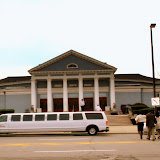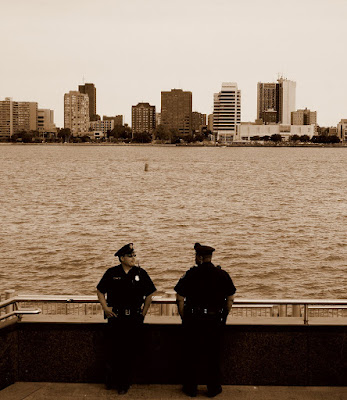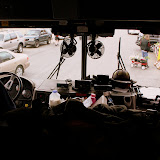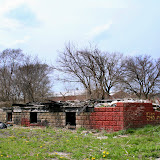Thursday, September 17, 2009
Monday, August 17, 2009
Sunday, July 19, 2009
Saturday, June 20, 2009
Wednesday, June 10, 2009
Crossroads to Motown...
Wednesday, June 3, 2009
Sunday, May 31, 2009
Thursday, May 28, 2009
Home Base
The Detroit Tigers played baseball on these grounds at the corner of Michigan and Turnbull for the first time in 1896 and continued through 104 subsequent seasons and 4 World Series wins. It began with patrons sitting in wooden stands and parts of the outfield marked by rope, and eventually grew to accomodate over 53,000 fans with steel and concrete bleechers and an extended double-upper-deck.
The Tigers moved to freshly built Comerica Park in the new millenium, and the following 7 years saw the old MLB stadium essentially unused-- costing the city over a half million a year to maintain. After much debate, the historic stadium was partially demolished in 2008, leaving an ache in the hearts of many longtime fans.
The Old Tiger Stadium Conservancy was established with the hopes of raising enough money to take ownership of the field and remaining grandstand, and restore it to be used as a museum and functional sporting complex. When OTSC failed to raise enough money (though not for lack of trying-- have you met Detroit sports fans?), Michigan Senator Carl Levin stepped up and slipped a provision into a massive 2009 omnibus spending bill, allocating $3.8 million "for preservation and redevelopment of a public park and related business activities in the Corktown Neighborhood."-- AKA Tiger Stadium.
Given Detroit's current economic situation, one might prefer that money be channeled into any number of other starving budgets, but a city this thick with nostalgia might just benefit from witnessing the restoration of a page of its ravaged history, and hopefully create a few new jobs in the process.
For now: Here it sits, waiting to come back to life.
UPDATE: $30 million was apparently not enough to save the stadium. The remaining grandstands are being torn down as we speak.
Monday, May 25, 2009
Listen to Detroit Techno

"The people [in Detroit] are really open at the moment and I think the parties are going off there in a different way than they are in other cities... With the bad economy and everything, people are getting more wild and being a bit more freaky.
...I was just talking about how Michigan is the raddest place to grow up. I think it's something about being a peninsula. We're isolated and have our own cultural references. It's the perfect incubator for radness and intellectual people who are really down-to-earth."
- Michigan native DJ Seth Troxler
[Performed @ Movement 09 : Detroit Electronic Music Festival]
Painting a Memory
Michigan Central Depot- Memorial Day, 2009- A local resident paints the giant 96 year old beauty, devastated by the fact that it could soon be demolished.
Sunday, May 24, 2009
Shadow Klan
Tuesday, May 12, 2009
Sunday, May 3, 2009
Me Gusta Mexicantown
 Organizers of Cinco de Mayo festivals in cities across America cancelled events amid concerns about the swine flu outbreak. In southwest Detroit, however, nothing would deter the hundreds of people who flocked to Mexicantown this weekend to celebrate Mexican heritage and culture.
Organizers of Cinco de Mayo festivals in cities across America cancelled events amid concerns about the swine flu outbreak. In southwest Detroit, however, nothing would deter the hundreds of people who flocked to Mexicantown this weekend to celebrate Mexican heritage and culture. A gentle breeze blew scents of corn tortillas and zesty fajitas across the grounds of Clark Park. Young and old alike danced to the buoyant sounds of a 15-man Spanish band. Vendors set up shop and sold a rich gamut of goods, from plastic Virgin Mary statues to cervezas and margaritas.
It was refreshing to see such a colorful and joyous celebration in the midst of this seemingly downtrodden city. I would highly recommend taking a trip to Mexicantown this May 5th if you missed the weekend’s festivities.
 |
| Cinco de Mayo, Mexicantown |
Kim's Take^
 |
| May2 |
Jen's Take^
East Grand Blvd. Day 1

She was posting a hand-made sign that read "Save America" with an army tank drawn next to it.
 |
| East Grand Blvd. |
Saturday, May 2, 2009
Toasty tidbit:
Before the auto industry made (and lost) Detroit millions, Michigan's major manufacturing interest was in stoves. For many years in the late 1800's, the (oven)Mitten was in fact "The World's Stove Capital".
A relic of Detroit's early industrial era, The Michigan Stove Company's massive Garland stove landmarked the corner of Jefferson and Adair from 1893 until 1927, at which point it was moved just west of the Belle Isle bridge. It now resides at the Michigan State Fairgrounds and maintains ranking as the world's largest stove.
The 15 ton giant was originally constructed for the World's Fair in Chicago in 1893.
*Quite a pleasant surprise as we rolled into MSFG at 8am for "Clean The D" this morning
Wednesday, April 29, 2009
Old Packard Plant
Designed by architect Albert Kahn, the 40 acre Packard Motor Car manufacturing complex was built in 1907 as the first concrete plant in the world. Packard manufactured luxury vehicles as well as Rolls-Royce Merlin engines (used in WWII fighters) in the growing complex (eventually 74 buildings covering 80 acres) until it merged with Studebaker in 1956 and left the plant behind.
It has since been abandoned, but has not gone entirely unused.
Seen as an elite rave venue in the 80's and early 90's, the Packard helped grow Detroit's still thriving techno scene.
Structural decay and heightened security has left the complex more lonely in recent years, but it remains a high-priority destination for serious graffiti artists and willing urban explorers.
We came across it by chance and were completely blown away by the place.
 |
| Old Packard Plant |
Sunday, April 26, 2009
Subscribe to:
Comments (Atom)
































